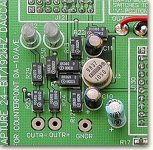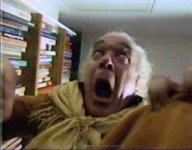I have never been much of a believer in Vishay, HolCo whatever exotic resistors. I have stuck to standard leaded, metal film components. Using some "high-quality" parts never made any perceptible difference. Only exception was the feedback resistor in my poweramp that dissipates several 10-100 mW depending on the output level. Paralling two standard metal film types sounded better than a single 0.1%, high stability, low TC Welwyn resistor...
Anyway, having done most of my last project in SMD, I am becoming increasingly annoyed with the layout problems of incorporating 0207 style leaded resistors. Plus drilling all the holes is a pain, too.
When sticking to metal film type SMD resistors, are there any reasons to prefer MELF/mini-MELF over chip type 0804 and 1206 resistors?
Another question: I have a lab set of 1% Epcos 0804 resistors. The vendor's catalog said they were thick film but there is nothing in the little sheet that came with the set. Epcos/Siemens have chip resistors in their list of available parts, but they don't state the technology. Going as far back as 1997 (I threw out the older catalogs), they never offered data sheets for their resistors.
The lowest tolerance thick film resistors I could find a data sheet for were Welwyn WCR resitors that use ruthenium oxide thick film and are available down to 2%.
So I thought my 1% resistors must be metal film. I scraped off the black coating. Unterneath, there is a black, rectangular patch that is about 1/3 the size of the subtrate and has metallic connections to the external solder faces. I suspect this is thick film. Any comments?
Anyway, having done most of my last project in SMD, I am becoming increasingly annoyed with the layout problems of incorporating 0207 style leaded resistors. Plus drilling all the holes is a pain, too.
When sticking to metal film type SMD resistors, are there any reasons to prefer MELF/mini-MELF over chip type 0804 and 1206 resistors?
Another question: I have a lab set of 1% Epcos 0804 resistors. The vendor's catalog said they were thick film but there is nothing in the little sheet that came with the set. Epcos/Siemens have chip resistors in their list of available parts, but they don't state the technology. Going as far back as 1997 (I threw out the older catalogs), they never offered data sheets for their resistors.
The lowest tolerance thick film resistors I could find a data sheet for were Welwyn WCR resitors that use ruthenium oxide thick film and are available down to 2%.
So I thought my 1% resistors must be metal film. I scraped off the black coating. Unterneath, there is a black, rectangular patch that is about 1/3 the size of the subtrate and has metallic connections to the external solder faces. I suspect this is thick film. Any comments?
Hi eric
I have been asking myself the same question..
By using a minimelf in 1206 case you would get double powerdisipation, low noise.
BC components MMA0204 precision series. (+/-15ppm).
The BC components MMA0204 professional series can handle 28W or 2KV peak!!
Some of the normal 1206 are made with a thin carbon layer.
Maybe this is why the call the MMA0204 low noise types?
I have found a nice thin film precision divider from VISHAY :
MPM series.
Ratio tolerance .05%
TCR Ratio +/-2ppm.
Ratios:
100:1
50:1
25:1
20:1
10:1
5:1
2:1
1:1
It has nothing to do with what you asked for but i thought you should know.
Have a nice day
Sonny
I have been asking myself the same question..
By using a minimelf in 1206 case you would get double powerdisipation, low noise.
BC components MMA0204 precision series. (+/-15ppm).
The BC components MMA0204 professional series can handle 28W or 2KV peak!!
Some of the normal 1206 are made with a thin carbon layer.
Maybe this is why the call the MMA0204 low noise types?
I have found a nice thin film precision divider from VISHAY :
MPM series.
Ratio tolerance .05%
TCR Ratio +/-2ppm.
Ratios:
100:1
50:1
25:1
20:1
10:1
5:1
2:1
1:1
It has nothing to do with what you asked for but i thought you should know.
Have a nice day
Sonny
Do you know the Meggit series RN thin films, 0.1% 10ppm in a 0805 size ? They are sold by Radiospares and Farnell in low quantities and I use them for non-audio work (instrumentation...) I think they could be fine in some audio circuits.
The main difference I see between MELF (or miniMELF) and 0805 (or 1206) is the MELF are cylindrical with a spiral groove, i.e. inductive, and this could make a difference in some circuits.
The main difference I see between MELF (or miniMELF) and 0805 (or 1206) is the MELF are cylindrical with a spiral groove, i.e. inductive, and this could make a difference in some circuits.
At work I use a lot of SMT resistors, mostly 1206. Our mainstay is Vishay/Dale CRCW series (1% tolerance), which is thick film. For tight tolerance (0.1%) we use Vishay/Dale TNPW which is NiCr thin film. The TNPW can be had in 1% tolerance as well.
I've never used these in an audio project so I can't say which is better, though my guess is that the TNPW or similar thin film would be better.
If one wants to get really fancy with SMT resistors, there are the relatively new Vishay (aka, the 'real' Vishay) SMT lines which are essentially SMT versions of the foil-on-ceramic Vishay S102 styles. These tend to be in larger package styles than the normal 1206 SMT resistors.
I've never used these in an audio project so I can't say which is better, though my guess is that the TNPW or similar thin film would be better.
If one wants to get really fancy with SMT resistors, there are the relatively new Vishay (aka, the 'real' Vishay) SMT lines which are essentially SMT versions of the foil-on-ceramic Vishay S102 styles. These tend to be in larger package styles than the normal 1206 SMT resistors.
sonnya said:Hi eric
I have been asking myself the same question..
By using a minimelf in 1206 case you would get double powerdisipation, low noise.
BC components MMA0204 precision series. (+/-15ppm).
The BC components MMA0204 professional series can handle 28W or 2KV peak!!
These have steel caps and are magnetic.
KAO make an audio grade SMT resistor in 2% and 5%.
<a href="http://www.koaeurope.de/smd2000/smd2000.pdf/rk73ad.pdf">rk73ad.pdf</a>
Its listed on the US website, <a href="http://www.koaspeer.com/koa/index.html">KOA Speer US</a>, I get a error when I try to use their link??
I wonder if they supply samples?
Regards
James
<a href="http://www.koaeurope.de/smd2000/smd2000.pdf/rk73ad.pdf">rk73ad.pdf</a>
Its listed on the US website, <a href="http://www.koaspeer.com/koa/index.html">KOA Speer US</a>, I get a error when I try to use their link??
I wonder if they supply samples?
Regards
James
Harry,
Your picture shows one flavor of the Vishays; there is also another style that's more bare-bones and looks more like a standard SMT resistor though larger in size than the usual 1206
James,
I've used some KOA (non-audio work-related) and haven't been impressed with them.
As a broad-brushed pidgeon-holing, I'd equate thick film to carbon film in leaded resistors and thin film to metal film.
As to MELFs, they seem peculiar to Europe for the most part and I don't think I'd search them out for any reason.
I'll have to inquire around the old workplace for more information on thick film as my company has used them in hybrids for years.
Your picture shows one flavor of the Vishays; there is also another style that's more bare-bones and looks more like a standard SMT resistor though larger in size than the usual 1206
James,
I've used some KOA (non-audio work-related) and haven't been impressed with them.
As a broad-brushed pidgeon-holing, I'd equate thick film to carbon film in leaded resistors and thin film to metal film.
As to MELFs, they seem peculiar to Europe for the most part and I don't think I'd search them out for any reason.
I'll have to inquire around the old workplace for more information on thick film as my company has used them in hybrids for years.
fmak said:These have steel caps and are magnetic. [/B]
I am now asking a a question wich may heat things up a bit.... and bit off the line of this thread.
Have any one done a blind test with to equal system where testet. One system who have demagnitized and one who have not been.
I am serious about it... Some designers in denmark make demagnitizers... I have not used them as i am bit sceptical about them... The same way like Elliot...
For the one Harry showed up (Vishay SMR1D) I have just found out that they are located next to MMA0204 in the Farnell Catalogue... How can i be so blind 😉 I thought they where Wirewound types...
By the way : Nice pricetag $10/unit!!
For the KOA resistors ... a tempco of +/-200ppm ... 10 times higher than the most high precision resistors...
Sonny
sonnya said:
For the one Harry showed up (Vishay SMR1D) I have just found out that they are located next to MMA0204 in the Farnell Catalogue... How can i be so blind 😉 I thought they where Wirewound types...
You should order through Vishay dealer; cheaper and there is no need for 0.1%!
Fred:😛
Harry,
the picture you have attached seems to contain two of those polystyrene caps with the leads just stuck into the roll. Is that excellent taste in components or does it just not matter in this application?
Eric
the picture you have attached seems to contain two of those polystyrene caps with the leads just stuck into the roll. Is that excellent taste in components or does it just not matter in this application?
Eric
Harry,
the picture you have attached seems to contain two of those polystyrene caps with the leads just stuck into the roll. Is that excellent taste in components or does it just not matter in this application?
Eric
the picture you have attached seems to contain two of those polystyrene caps with the leads just stuck into the roll. Is that excellent taste in components or does it just not matter in this application?
Eric
Resistor paper
Where it all started for the resistor madness
http://www.sasaudiolabs.com/resistor.htm
H.H.
Where it all started for the resistor madness
http://www.sasaudiolabs.com/resistor.htm
H.H.
- Status
- Not open for further replies.
- Home
- Amplifiers
- Solid State
- "correct" SMD resistors to use?

